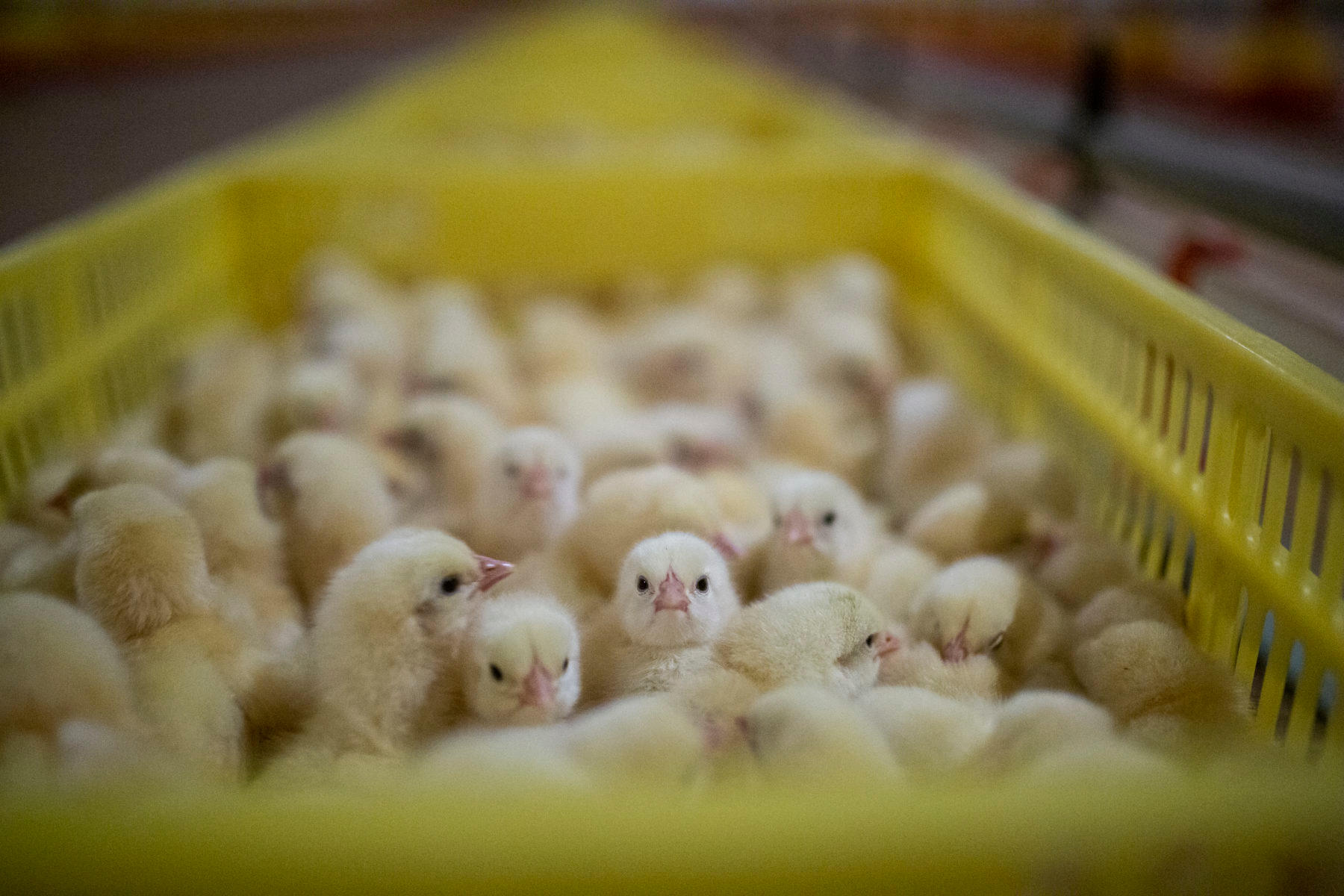




Food service companies represent a multi-billion dollar industry. But as the industry continues to grow, so does the animal abuse rampant in its supply chain.

When you visit a college dining hall, stop by a hospital cafeteria, or attend a catered event at a hotel, the food you’re eating probably comes from a food service company. Representing a $45 billion industry, today’s leading food service companies are only expected to grow as consumers return to in-person gatherings. Unfortunately, many of these companies have been less than successful when it comes to making progress on animal welfare—and it’s time they’re held accountable.
What are food service companies?
Food service companies, also called foodservice providers, supply different types of institutions (whether commercial, governmental, industrial, or educational) with the catering and dining services they need. That includes university dining halls, airport food courts, hospital cafeterias, food at sports venues, catered events at hotels, and more.
At the supermarket, consumers generally have a bounty of offerings to choose from. They can “vote with their wallets” by selecting plant-based and organic food. But at many of the venues providing meals from food service companies, consumer choices are much more limited. Think about it: At a hotel event, do you have the option to choose cage-free or free-range eggs? Chances are, that choice has already been decided for you—and it might not be a choice you agree with.
Employing more than half a million workers, the foodservice provider industry is large—and it’s only expected to grow. As income levels rise, businesses reopen, and consumers return to in-person gatherings, foodservice industry revenue is projected to rise in coming years. And that means the number of farmed animals moving through the food service supply chain—already in the billions—will rise, too.
What is ESG in food service?
Over the last few decades—largely thanks to consumer pressure—the clients of food service companies have started to prioritize Environmental, Social, and Governance (ESG) standards. These are higher operational standards that align with sustainability, social responsibility, and animal welfare. Animal welfare, in particular, has gone from being a fringe issue to a bare minimum that consumers expect.
“Today’s consumers are increasingly aware of how their purchasing choices impact the world around us. They want to see companies with the same approach,” says Vicky Bond, President of The Humane League. “Research is showing us that people care deeply about how animals are raised and treated. They want to spend their money with brands they can trust, brands who make animal welfare a priority.”
In response, hundreds of companies across the nation have adopted policies to protect animals from abuse. For example, massive hotel chains—including Hilton Hotels, Marriott International, and Four Seasons—have all publicly committed to source and sell only cage-free eggs. As consumers demand higher standards for animal welfare, and institutions prioritize ESG criteria, it’s clear that foodservice providers need to step up their game… or risk losing their clients.
What are the biggest food service companies?
Here are the top 10 food service companies today:
- Compass Group North America
- Sodexo Inc.
- Aramark Corp.
- Delaware North Companies
- HMSHost
- Elior North America
- Healthcare Services Group
- AVI Foodsystems Inc.
- Thompson Hospitality
- Southwest Foodservice Excellence
How do food service companies stack up on animal welfare?
In a new report by The Humane League, we ranked today’s leading foodservice providers on their animal welfare policies in three categories: egg-laying hens, chickens raised for meat, and breeding pigs. Representing the majority of animals moving through the food service supply chain, chickens and pigs are subjected to extreme abuse every step of the way.
Gestation crates
When female pigs, known as sows, are impregnated to produce piglets for food, they are kept in small metal crates for the entirety of their pregnancies. These gestation crates are so tight that the mother pigs cannot stand or turn around. According to the USDA, gestation crates weaken pigs' cardiac functions, immune systems, and bone strength—and constant rubbing against the bars results in painful sores and abrasions.
Battery cages
Egg-laying hens face some of the worst abuses of any factory-farmed animal, largely due to the use of outdated battery cages. With four to ten birds packed into each tiny cage, hens suffer from broken bones, open lesions, and torn feathers. Along with physical suffering, battery cages cause acute psychological distress by suppressing hens’ instinctive nesting and social behaviors like perching, roosting, dust bathing, and exploring. Many caged hens resort to behaviors associated with chronic stress, such as self-mutilation or pulling out their cage-mates’ feathers.
Chickens raised for meat
Broiler chickens live most of their short lives—often six or seven weeks—in dark, densely packed barns where feces accumulates on the ground, generating ammonia that leaves burns on the animals’ bodies. At slaughter, the majority die by a gruesome method that subjects chickens to electrocution, throat cutting, and boiling, sometimes alive. Because the vast majority of broilers have been selectively bred over decades to grow extremely large at an explosive rate, they experience a range of negative health conditions like high blood pressure, swollen abdomens, and cardiac arrest.
2022 Foodservice Provider Guide
In our research for this 2022 Foodservice Provider Guide, we found that while many foodservice providers have animal welfare policies in place, the policies are often vague—and some have even been removed. When companies don’t follow through on their animal welfare commitments, they become meaningless and mislead customers—while animals suffer the consequences. Meanwhile, these companies benefit from the positive public recognition associated with better animal welfare, profiting off of cruelty and empty promises.
For example, Sodexo is a company that claims to care about animal welfare. It was one of the first companies to adopt a set of standards for meat chicken known as the Better Chicken Commitment in 2016. However, nearly six years later, the company has not even demonstrated how it plans to make progress toward this goal.
Similarly, while food service giants Aramark and Compass Group announced progressive animal welfare policies back in 2016, Aramark is not actively following through on its commitments and has declined to respond to requests for information—and Compass has yet to show how it has made or plans to make progress toward purchasing higher-welfare chicken.
How you can help
As a highly competitive industry, the clients of foodservice providers are always looking for a company that could better meet their needs. And as college dining halls, office cafeterias, and hotel events open up once again, the foodservice industry is more competitive than ever—and therefore uniquely vulnerable to consumer pressure.
Let’s take advantage of this unique moment to show these companies—and their clients—that customers won’t stand for animal cruelty. Please join us in calling on foodservice providers to end the worst farming practices and create the compassionate future that pigs and chickens deserve. Together, we can show foodservice providers that cruelty has no place on our plates.





